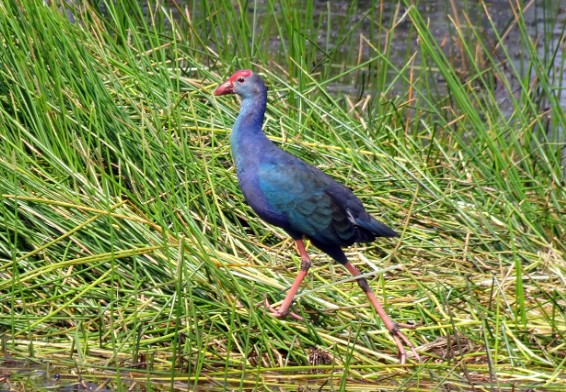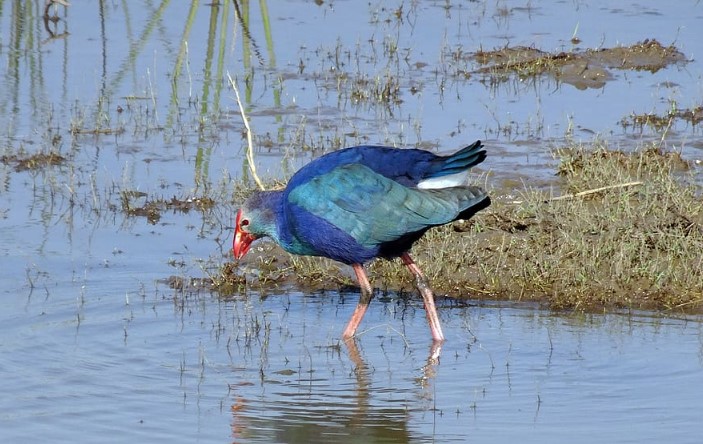Clambering through swamp vegetation, the purple Swamphen (Porphyrio porphyrio) supports its weight by gripping several red stems with its big feet.
It is also known as the Purple Gallinule or Bald Coot. The size of Purple Swamphen is about 440–480 mm long. It can swim, but rarely, and run fast on land. During much of the day, the swamphen stays in dense reed beds, wading among them or resting on roost platforms. However, it also moves into the adjacent wet pasture and uses swords to graze. Purple Swamphen calls a loud, harsh screeching call that resembles kee-oww, frequently heard at night. Soft chuck-chuck notes between group members while feeding.

Purple Swamphen eats herbs, seeds, fruit, eggs, small vertebrates, insects, spiders, and molluscs, but its diet centers on young red stems. It bites off at the base with its pincer-like bill and then grips them in one foot to eat them, often discarding much. All the while, it jerks its stubby tail up and down, flashing its white undertail. Swamphens in marginal or seasonal habitats wander widely, while those in permanent swamps are sedentary. They live in territorial groups of two to ten of both sexes year-round. The grey-headed swamphen (Porphyrio poliocephalus) is subspecies of purple swamphen.
The dominant males defend the territory and mate more successfully, displaying in front of females holding plants in the bill, bowing, and chuckling. All construct a single nest, in which several females may lay, and all incubate, the dominant birds most. A nursery nest is also made for chicks, where they are brooded at night and led to forage, mostly by subordinate adults.
The nesting and breeding process occurs every month, but primarily between August and February. Nest large platforms of reeds trampled down to form a dished nest sparsely lined with grasses, up to 30 cm across, 4–10 cm deep. The bird lays 3 to 8 eggs, which are buff to pale green, spotted, and blotched with red-brown and purple; they are oval, about 50 x 36 mm. Incubation is 23–29 days, by group.

There is a similarity between the sexes; the male is larger with a bigger frontal shield. The upper parts and wings are dusky, with a dark blue collar in the east; the fore-bend of the wings is deep blue or turquoise. The face is dusky; the neck, breast, and upper belly are deep blue in the east, all turquoise in the southwest; the lower belly is black; and the tail is pure white. Their eyes are red. The massive bill and frontal shield are bright red. Feet are pink-red with dark joints. The immature bird is dull in all parts; its front shield is small. Downy Young is black, with silver tips on the head and back; the bill is lemon cream with a pink base and red frontal spot.
Purple Swamphen found on banks of freshwater and sometimes saline swamps, lakes, and streams, throughout eastern Australia, northwest to the Kimberley. It also has an isolated population in the southwest. About 10-12 races; two in Australia: one in the east and northwest; the other paler, more turquoise, with a square-cut shield in the southwest.
Read More: American coot (Fulica Americana)







